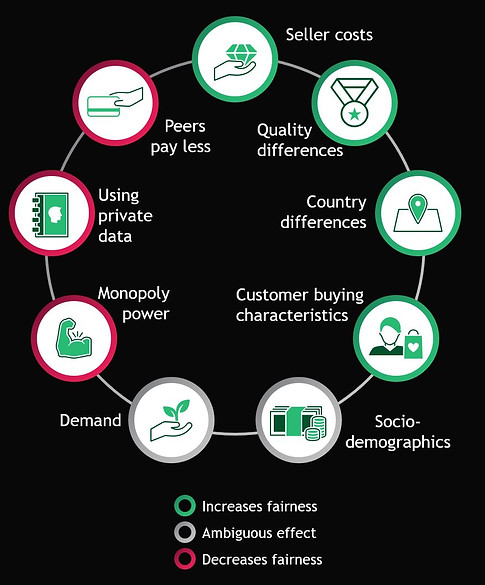JEAN-MANUEL IZARET
BEST-SELLING AUTHOR // PRICING CONSULTANT // RESEARCHER // SPEAKER // TEACHER
FAIRNESS IN PRICING
August 2019
Fairness is about relative treatment
Therefore the fairness of a company's pricing practices needs to evaluated along two dimensions
-
Fairness of pricing of customers compared with each other: Fairness vs. Peers
-
Fairness of how the value is shared between the seller and the buyer: Value Sharing Fairness
With the BCG, we conducted a global survey to assess how consumers perceive the fairness of various pricing practices in different industries.
-
Countries surveyed included: US, China, India, Brazil, Japan, Germany, France, Sweden
-
Product categories included: Banking, Electronics, Groceries, Hospitality, Movie Theaters, Pharmacy, Internet, Gas stations, University
-
Customers categories included: Seniors discounts, Student discounts, Geographic price differences, Time of purchase, Channel of purchase, Relative income of purchaser etc.

Fairness vs. Peers
People across the world think it is fair
-
to increase prices for high cost-to-serve customers
-
charge more for better products
-
charge different prices in different countries
-
vary price to drive customer behavior e.g. lower prices for loyal customers, happy hours etc.
Alternatively customers feels cheated when
-
customer similar to them get lower prices
-
Companies beware of random discounts
-
-
use their private data to change prices
-
"we saw you were rich, so we charge more
-
-
a company has monopoly power
Social norms and values drive different perceptions of
-
whether students deserve discounts
-
conservatives disagree especially when older
-
-
whether it's fair to increase gas prices at rush hour
-
people familiar with the practice say it's fine
-
-
whether airlines are right to price seats differently
-
Students majoring in economics think it's OK
-
but others tend to be suspicious
-




Value Sharing Fairness
Fairness as a function of share of value
captured by supplier
The value created by a transaction between a buyer and a seller can defined as:
Customer value - Variable cost
That value is shared between parties
-
Supplier gets his margin: Price - Variable cost
-
Buyer gets the Surplus: Customer value - Price
How that value is shared affects peoples behavior
-
customer would rather not buy than rewarding a company who takes a too high proportion of value
-
They are ready to suffer in order to avoid encouraging a company that does not share enough
By default people perceive a fair split is 50/50 but this varies depending on level of economic development
-
Developed country consumers think they should get at least 50% of the value but
-
they will accept up to 70% before not buying
-
-
In developed countries consumers think it is fair for companies to get most of the value
Current perceptions of fairness tend to accentuate inequalities in societies
Two trends, based in consumer perception of fair Pricing, tend to reinforce growing inequalities
-
Consumer are not in favor of pricing practices that would lower prices for lower income customers
-
Flat pricing tends to favor "high value" customers who are often wealthier
-
-
Consumers accept transactions even when they know companies get a higher share of the value
-
That higher share of value tends to flow to shareholders who are disproportionately wealthier
-